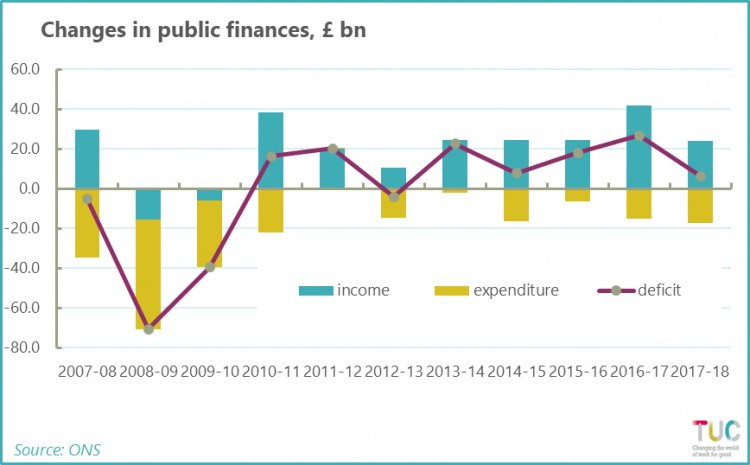The Chancellor finally admits austerity was a political choice
Earlier this week, the Chancellor finally admitted what we’ve been saying for years: that the best way to repair the public finances is not to cut spending but to get the economy growing.
Workers have put up with eight long years of austerity in the name of ‘balancing the books’ – a goal so sacrosanct that the coalition government tried to put it into law.
But at this week’s Treasury Committee, the Chancellor confessed that the easiest way to get debt down as a percentage of GDP was to “get the economy growing faster with higher trend productivity growth…grow the GDP, strong real wage growth, rising living standards”.
You can watch the clip below:
We couldn’t agree more with the Chancellor's assessment, but why has it taken him so long to admit that austerity was a political choice not an economic necessity?
And if the austerity agenda has finally been binned, why is it still being put into practice?
Wrong from day one
In our Budget submission to the Treasury, we were clear that the economy determines the public finances, not the other way around.
The chart below shows how annual changes in the deficit depend on how much the government spends (expenditure) and how much it collects in revenue (income). In this model, revenue increases are positive and spending increases are negative.

We can see that the worsening public finances during the global recession reflected a collapse in income rather than high expenditure.
Similarly, the improved finances in 2010-11 came on the back of a significant revival in government revenues, not from a reduction in government expenditure.
So when the coalition government came to power in May 2010, the then Chancellor George Osborne actually inherited recovering growth and improving public sector finances.
Failed project, failed Chancellor
Instead of building on this growth, Osborne introduced huge cuts to government expenditure in an attempt to bring the public debt and deficit under control.
The plan failed almost immediately.
As income collapsed in 2012-13 improvements to the deficit were reversed, forcing Osborne to retreat on his spending cuts.
Growth eventually returned thanks in no small part to Bank of England subsidies to the financial sector, but progress was very slow.
In the end it took the Treasury twice as long as to balance the books than he expected.
And because it took so long, the government missed all its targets for reducing the public debt.
Osborne’s mistake was to ignore the link between increasing spending to boost economic growth and the improved government revenues and public finances that result.
It’s taken eight years, but the penny seems to have finally dropped for his successor.
Austerity must end
The Chancellor now needs to embrace the logic of his newfound enlightenment.
He must understand that increased government spending will boost the economy and tackle the ongoing wage growth crisis, and that this will bring higher tax revenues to help cut the deficit.
So far Philip Hammond’s approach to the public finances has at least been better than his predecessors.
Upon taking office Hammond junked the ludicrous balanced budget legislation, and there was no ‘punishment Budget’ after the EU referendum.
And in his latest Budget, he didn’t let a small deficit stand in the way of much needed extra spending for the NHS.
But there’s still a long way to go to undo the damage wrought by eight years of austerity, and last month’s Budget barely scratched the surface.
Now that the logic behind austerity has been junked, we need action that matches the scale of the crisis facing working people in this country.
In the meantime we rejoice that what was once political heresy has become conventional economic wisdom within the Conservative Party.
It’s great that the Chancellor has finally admitted what we’ve long argued.
It’s just a shame that so many workers had to suffer before he got the message.
Stay Updated
Want to hear about our latest news and blogs?
Sign up now to get it straight to your inbox

